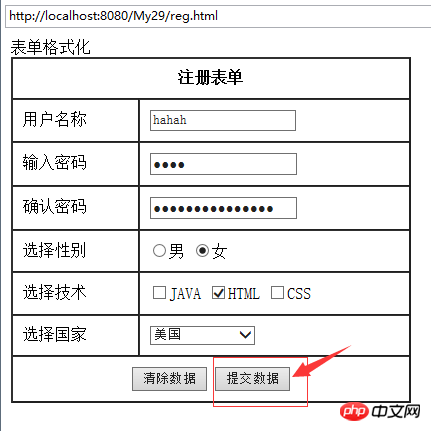 Web-Frontend
Web-Frontend
 HTML-Tutorial
HTML-Tutorial
 Beispielcode-Sharing zum Unterschied zwischen den HTML-Übermittlungsmethoden Post und Get
Beispielcode-Sharing zum Unterschied zwischen den HTML-Übermittlungsmethoden Post und Get
Beispielcode-Sharing zum Unterschied zwischen den HTML-Übermittlungsmethoden Post und Get
Der Unterschied zwischen den HTML-Übermittlungsmethoden Post und Get (experimentell)
1. Der Unterschied zwischen Post und Get
Get Submission, die übermittelten Informationen werden in der Adressleiste angezeigt.
Nach der Übermittlung werden die übermittelten Informationen nicht in der Adressleiste, sondern im Nachrichtentext angezeigt.
2. Client-Code
<!DOCTYPE html><html><head><title>Form.html</title>
<meta name="keywords" content="keyword1,keyword2,keyword3">
<meta name="description" content="this is my page">
<meta name="content-type" content="text/html; charset=GB2312">
<!--<link rel="stylesheet" type="text/css" href="./styles.css">-->
</head><body>
<!--提交方式:get提交。地址栏:http://localhost:9891/?user=abc&psw=123&repsw=123&sex=nan&tech=java&tech=html&country=cn
GET /?user=abc&psw=123&repsw=123&sex=nan&tech=java&tech=html&country=cn HTTP/1.1
Accept: image/gif, image/x-xbitmap, image/jpeg, image/pjpeg, application/x-shockwave-flash, application/vnd.ms-excel, application/vnd.ms-powerpoint, application/msword, */*
Accept-Language: zh-cn,zu;q=0.5
Accept-Encoding: gzip, deflate
User-Agent: Mozilla/4.0 (compatible; MSIE 6.0; Windows NT 5.1; SV1; InfoPath.2)
Host: localhost:9891
Connection: Keep-Alive
提交方式:POST地址栏:http://localhost:9891/POST / HTTP/1.1
Accept: image/gif, image/x-xbitmap, image/jpeg, image/pjpeg, application/x-shockwave-flash, application/vnd.ms-excel, application/vnd.ms-powerpoint, application/msword, */*
Accept-Language: zh-cn,zu;q=0.5
Content-Type: application/x-www-form-urlencoded
Accept-Encoding: gzip, deflate
User-Agent: Mozilla/4.0 (compatible; MSIE 6.0; Windows NT 5.1; SV1; InfoPath.2)
Host: localhost:9891
Content-Length: 68
Connection: Keep-Alive
Cache-Control: no-cacheuser=hahah&psw=8989&repsw=8989&sex=nv&tech=html&tech=css&country=usa
GET提交和POST提交的区别?
1,
get提交,提交的信息都显示在地址栏中。
post提交,提交的信息不显示地址栏中。
2,
get提交,对于敏感的数据信息不安全。
post提交,对于敏感信息安全。
3,
get提交,对于大数据不行,因为地址栏存储体积有限。
post提交,可以提交大体积数据。
4,
get提交,将信息封装到了请求消息的请求行中。
post提交,将信息封装到了请求体中。
在服务端的一个区别。 如果出现将中文提交到tomcat服务器,服务器默认会用iso8859-1进行解码会出现乱码,
通过iso8859-1进行编码,在用指定的中文码表解码。即可。
这种方式对get提交和post提交都有效。
但是对于post提交方式提交的中文,还有另一种解决办法,就是直接使用服务端一个对象
request对象的setCharacterEncoding方法直接设置指定的中文码表就可以将中文数据解析出来。
这个方法只对请求体中的数据进行解码。
综上所述:表单提交,建议使用post。
和服务端交互的三种方式:
1,地址栏输入url地址。get
2,超链接。 get 3,表单。 get 和 post
如果在客户端进行增强型的校验(只要有一个组件内容是错误,是无法继续提交的。只有全对才可以提交)
问,服务端收到数据后,还需要校验吗?
需要,为了安全性。
为了信息安全,也为了客户端那边不要乱提交数据,客户端和服务端都需要做校验。
如果服务端做了增强型的校验,客户端还需要校验吗? 需要,因为要提高用户的上网体验效果,减轻服务器端的压力。
-->
表单格式化 <br>
<!-- action里面的http协议不能忘记 -->
<form action="http://localhost:9891" method="post">
<!--
cellpadding 属性规定单元边沿与其内容之间的空白。
注释:请勿将该属性与 cellspacing 属性相混淆,cellspacing 属性规定的是单元之间的空间。
从实用角度出发,最好不要规定 cellpadding,而是使用 CSS 来添加内边距。 -->
<table border="1" bordercolor="#00ffff" cellpadding=10 cellspacing=0 width=400>
<!-- 由此可见,<th>和<td>标签都是用于表格单元格显示的。不同的是<th>在单元格中加粗显示。 -->
<tr>
<!-- 占两列 -->
<th colspan="2">注册表单</th>
</tr>
<tr>
<td>用户名称</td>
<td><input type="text" name="user" value=""><br /></td>
</tr>
<tr>
<td>输入密码</td>
<td><input type="password" name="pwd" /><br /></td>
</tr>
<tr>
<td>确认密码</td>
<td><input type="password" name="repwd" /><br /></td>
</tr>
<tr>
<td>选择性别</td>
<td><input type="radio" name="sex" value="nan" />男 <input type="radio" name="sex" value="nv" checked="checked" />女<br /></td>
</tr>
<tr>
<td>选择技术</td>
<td><input type="checkbox" name="tech" value="java" />JAVA <input type="checkbox" name="tech" value="html" />HTML <input type="checkbox" name="tech" value="css" />CSS <br /></td>
</tr>
<tr>
<td>选择国家</td>
<td><select name="country">
<option value="none">--选择国家--</option>
<option value="usa">美国</option>
<option value="en">英国</option>
<!-- 默认选择中国 -->
<option value="cn" selected="selected">中国</option>
</select></td>
</tr>
<tr>
<th colspan="2"><input type="reset" value="清除数据" /> <input type="submit" value="提交数据" /></th>
</tr>
</table>
</form></body></html>/**
*
*/
package cn.itcast.server;
import java.io.IOException;
import java.io.InputStream;
import java.io.PrintWriter;
import java.net.ServerSocket;
import java.net.Socket;
/**
* @author Fry
*
*/
public class RegServer {
/**
* @param args
* @throws Exception
*/
public static void main(String[] args) throws Exception {
ServerSocket ss = new ServerSocket(9891);//新建服务端端口
Socket s = ss.accept();//端口监听
//输出服务器主机地址 ans:0:0:0:0:0:0:0:1
System.out.println(s.getInetAddress().getHostAddress());
InputStream in = s.getInputStream();//字节输入流,用来接收客户端消息
byte[] buf = new byte[1024];//1024字节的缓存
int len = in.read(buf);//将收到的消息读到buf中
//输出接收到的页面消息 包括消息行 消息头 消息体
System.out.println(new String(buf,0,len));
//字符输出,用来存储发送给客户端的消息
PrintWriter out = new PrintWriter(s.getOutputStream(),true);
//客户端接收到的消息
out.println("<font color='green' size='7'>注册成功</font>");
//关闭端口
s.close();
ss.close();
}
}
Das obige ist der detaillierte Inhalt vonBeispielcode-Sharing zum Unterschied zwischen den HTML-Übermittlungsmethoden Post und Get. Für weitere Informationen folgen Sie bitte anderen verwandten Artikeln auf der PHP chinesischen Website!

Heiße KI -Werkzeuge

Undresser.AI Undress
KI-gestützte App zum Erstellen realistischer Aktfotos

AI Clothes Remover
Online-KI-Tool zum Entfernen von Kleidung aus Fotos.

Undress AI Tool
Ausziehbilder kostenlos

Clothoff.io
KI-Kleiderentferner

AI Hentai Generator
Erstellen Sie kostenlos Ai Hentai.

Heißer Artikel

Heiße Werkzeuge

Notepad++7.3.1
Einfach zu bedienender und kostenloser Code-Editor

SublimeText3 chinesische Version
Chinesische Version, sehr einfach zu bedienen

Senden Sie Studio 13.0.1
Leistungsstarke integrierte PHP-Entwicklungsumgebung

Dreamweaver CS6
Visuelle Webentwicklungstools

SublimeText3 Mac-Version
Codebearbeitungssoftware auf Gottesniveau (SublimeText3)

Heiße Themen
 1378
1378
 52
52
 Tabellenrahmen in HTML
Sep 04, 2024 pm 04:49 PM
Tabellenrahmen in HTML
Sep 04, 2024 pm 04:49 PM
Anleitung zum Tabellenrahmen in HTML. Hier besprechen wir verschiedene Möglichkeiten zum Definieren von Tabellenrändern anhand von Beispielen für den Tabellenrand in HTML.
 HTML-Rand links
Sep 04, 2024 pm 04:48 PM
HTML-Rand links
Sep 04, 2024 pm 04:48 PM
Anleitung zum HTML-Rand links. Hier besprechen wir einen kurzen Überblick über HTML margin-left und seine Beispiele sowie seine Code-Implementierung.
 Verschachtelte Tabelle in HTML
Sep 04, 2024 pm 04:49 PM
Verschachtelte Tabelle in HTML
Sep 04, 2024 pm 04:49 PM
Dies ist eine Anleitung für verschachtelte Tabellen in HTML. Hier diskutieren wir anhand der entsprechenden Beispiele, wie man eine Tabelle innerhalb der Tabelle erstellt.
 HTML-Tabellenlayout
Sep 04, 2024 pm 04:54 PM
HTML-Tabellenlayout
Sep 04, 2024 pm 04:54 PM
Leitfaden zum HTML-Tabellenlayout. Hier besprechen wir die Werte des HTML-Tabellenlayouts zusammen mit den Beispielen und Ausgaben im Detail.
 HTML-Eingabeplatzhalter
Sep 04, 2024 pm 04:54 PM
HTML-Eingabeplatzhalter
Sep 04, 2024 pm 04:54 PM
Leitfaden für HTML-Eingabeplatzhalter. Hier besprechen wir die Beispiele für HTML-Eingabeplatzhalter zusammen mit den Codes und Ausgaben.
 HTML-geordnete Liste
Sep 04, 2024 pm 04:43 PM
HTML-geordnete Liste
Sep 04, 2024 pm 04:43 PM
Leitfaden zur HTML-geordneten Liste. Hier besprechen wir auch die Einführung von HTML-geordneten Listen und Typen sowie deren Beispiele
 Text in HTML verschieben
Sep 04, 2024 pm 04:45 PM
Text in HTML verschieben
Sep 04, 2024 pm 04:45 PM
Anleitung zum Verschieben von Text in HTML. Hier besprechen wir eine Einführung, wie Marquee-Tags funktionieren, mit Syntax und Beispielen für die Implementierung.
 HTML-Onclick-Button
Sep 04, 2024 pm 04:49 PM
HTML-Onclick-Button
Sep 04, 2024 pm 04:49 PM
Anleitung zum HTML-OnClick-Button. Hier diskutieren wir deren Einführung, Funktionsweise, Beispiele und Onclick-Events in verschiedenen Veranstaltungen.



